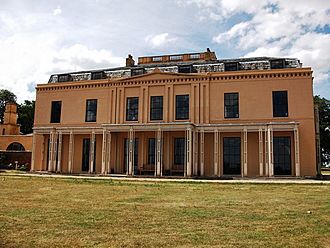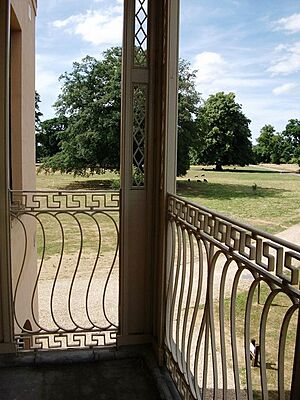Moggerhanger House facts for kids
Quick facts for kids Moggerhanger House |
|
|---|---|
 |
|
| General information | |
| Type | Manor house |
| Architectural style | Georgian architecture |
| Location | Moggerhanger, Bedfordshire |
| Country | England |
| Coordinates | 52°07′29″N 0°20′34″W / 52.12465°N 0.34291°W |
| Ordnance Survey | TL1353248665 |
| Construction started | 1790 |
| Completed | 1812 |
| Renovated | 1994 |
| Design and construction | |
| Architect | John Soane |
| Other designers | Humphry Repton |
| Renovating team | |
| Architect | Peter Inskip |
Moggerhanger House is a beautiful old country house in Moggerhanger, Bedfordshire, England. It's a very important building, known as a Grade I-listed site. This means it's one of the most special historic buildings in the country. A famous architect named John Soane designed it.
Today, a Christian charity called Harvest Vision and the Moggerhanger House Preservation Trust own the house. It recently had a huge restoration project, costing about £7 million. Many groups helped with this, like the Heritage Lottery Fund and English Heritage.
Contents
History of Moggerhanger House
The house at Moggerhanger started as a smaller building with a classic Georgian architecture style.
How the House Grew
In the 1790s, Godfrey Thornton bought the house. He was a director at the Bank of England. He asked the Bank's architect, John Soane, to redesign it. Soane worked on the house between 1790 and 1793.
Even more work happened when Godfrey's son, Stephen Thornton, inherited the house. Soane continued to expand and improve it from 1806 until 1812. During this time, Soane was also rebuilding the Bank of England. He completely changed Moggerhanger House, making it bigger and moving the main entrance. He also put on a new roof. Soane used his earlier designs from 1793 and made sure everything looked balanced and classic. He even used the house to try out new decorating ideas for his future projects.
Soane's Special Design
John Soane used a new material called "Parker's Roman Cement" to cover the house. It was a biscuit-brown color. The side of the house facing the garden has a wooden porch. The main entrance has a round porch with Greek-style columns. Inside, there was once a round entrance hall with a shallow dome. The windows were designed to make the openings look like pure shapes. There's also a cool staircase that seems to float without support.
The beautiful gardens around the house were designed by another famous person, Humphry Repton. Moggerhanger House is one of only a few houses designed by Soane that are still standing today.
Moggerhanger as a Hospital
For most of the 1900s, Moggerhanger House was used as a hospital. In 1919, it became a hospital for people with Tuberculosis (TB). Later, in the late 1950s, it became a hospital for bone problems. It was renamed Park Hospital in 1960 but closed in 1987.
Modern Era and Restoration
After closing as a hospital, the house was bought by developers. It started to fall apart with leaky roofs and wood rot.
Saving the House
In 1993, the developers got permission to build 12 small houses on the grounds. This was allowed so they could afford to give the main house to a Christian trust called Harvest Vision. Harvest Vision bought the house for just £1, agreeing to take on the big job of repairing it. They estimated the repairs would cost £350,000.
Harvest Vision raised money from supporters and bought more parts of the estate, like the Stable Block and Gatehouses. Many volunteers helped start the restoration work. English Heritage even gave a grant to replace the roof.
A Major Upgrade
In 1997, Moggerhanger House was recognized as even more important. Its listing was upgraded from Grade II* to Grade I. Because it was the only country house by Sir John Soane that could be fully restored, English Heritage encouraged Harvest Vision to apply for a large grant.
The National Heritage Memorial Fund offered a £3.5 million grant. But there was a condition: the 12 houses planned earlier could not be built. Harvest Vision then got another grant to buy the land where those houses would have been. This was amazing because it meant the original gardens designed by Humphry Repton could also be restored!
The big grant was paid through the new Heritage Lottery Fund. A special trust, the Moggerhanger House Preservation Trust (MHPT), was set up in 1998 to manage the restoration of both Soane's architecture and Repton's landscape.
Peter Inskip, an architect who knew a lot about Sir John Soane's work, oversaw the restoration. He said that Soane's long connection with the house allowed him to try out new ideas. This helped them learn about parts of Soane's other buildings that are now lost. The restoration showed that Moggerhanger House is a true work of art, just like the works of other great British architects like Inigo Jones, Christopher Wren, and Nicholas Hawksmoor.
The Restoration Continues
The initial restoration project took 10 years to finish. Harvest Vision created a small community of volunteers from local villages and churches. These volunteers helped complete the work and maintain the site while contractors were busy.
By 2003, a company called Moggerhanger Park Ltd was formed to help manage the house and its projects. This company worked closely with the local community. The Heritage Lottery Fund gave another £3.3 million, and by 2005, the total cost of restoration was about £7 million.
Some of Soane's experimental designs from Moggerhanger House were even used later in the Cabinet Room at 10 Downing Street, the home of the British Prime Minister!
The Garden Room, which was once a hospital ward, was moved and restored. It became a community space with a library and other facilities. It is now used for exhibitions and tea rooms.
In 2010, the charity bought more land next to the house, including Park Farm. This land was used for youth and community work.
Moggerhanger House Today
Today, Moggerhanger House is a busy place! For most of the year, it's used as a conference and training center. But from mid-June to mid-September, it opens its doors to tourists. You can take public tours twice a day during this time.
You can visit the beautiful grounds for free all year round. There's a lovely tea room where you can get a snack and a children's play area for younger visitors.
The house has become a hub for local community activities. Its successful restoration is a big achievement for the village and for Bedfordshire. The Moggerhanger House Preservation Trust is still working to raise money to restore the 33-acre (130,000 m2) parkland around the house, bringing Humphry Repton's original designs back to life.


